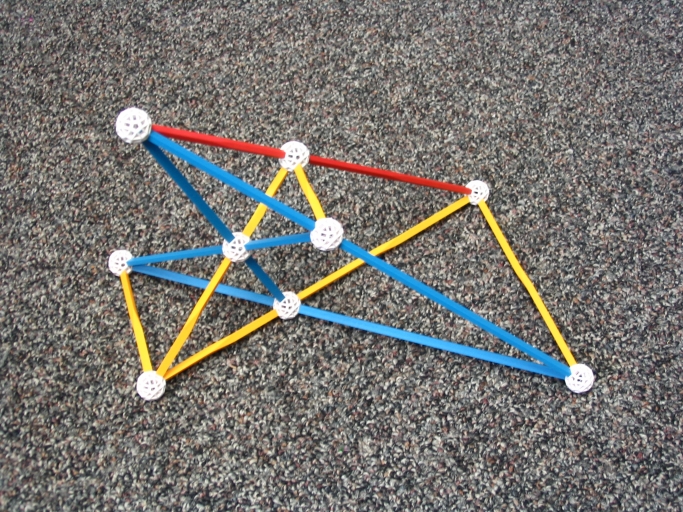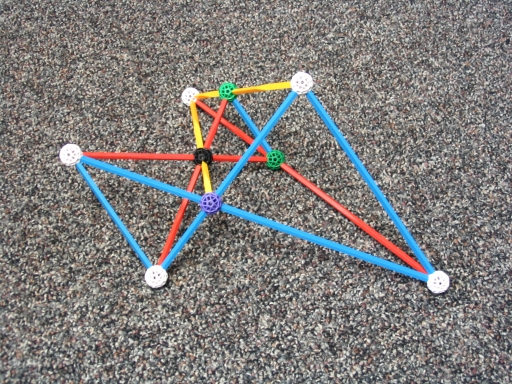The Configuration of Desargues in Zometool
Introduction.
Desargues's configuration is a point/line configuration consisting of 10
lines and 10 points arranged in such a way
that 3 points lie on every line and 3 lines lie on every point.
Desargues's configuration emerges from Desargues's theorem:
Since this is projective geometry, one also has a corresponding dual statement obtained by interchanging the words "point" and "line". If one draws all the points and lines that are mentioned in Desargues's theorem, then one sees a realization of Desargues's configuration. This theorem is valid for all projective spaces over the real numbers, and it is used as an axiom to distinguish various generalized projective geometries. Thus, naturally enough, one calls a projective geometry "Desarguesian" or "non-Desarguesian" depending respectively on whether or not this statement holds true universally.
Here is a depiction of the Desargues's configuration:
The two triangles in perspective are colored blue and red. In particular, notice that (i) the three green lines formed by joining vertices from the two triangles are concurrent, and (ii) the points formed by the intersections of pairs of the sides of the triangles all lie on the black line. Due to (i), we say the two triangles are "perspective from a point" and, due to (ii), we say that the triangles are "perspective from a line".
One may also form Desargues's configuration by uniting a complete quadrangle with a complete quadrilateral. Here, a "complete quadrilateral" is an arrangement of 4 lines in general position taken with all 6 intersection points, and a "complete quadrangle" is any arrangement of 4 points in general position taken with all 6 of the lines joining all the pairs of points. As a matter of fact, Desargues's configuration has the additional property that, given any embedded complete quadrilateral, the remaining elements comprise a complete quadrangle. Moreover, by duality, this statement describing the configuration remains valid when we interchange the words "quadrangle" and "quadrilateral".
Zometool.
It is a remarkable fact that one may make a model of Desargues's configuration in Zometool:

Figure 2. Zome Model of the Desargues Configuration.
In this model, 9 points are represented by connectors, 3 lines are represented by a single strut each, and 7 lines are each represented by a pair of collinear struts. Thus, this model uses a total of 17 struts. The lines represented by a single strut are mutually parallel, meeting at a point in the "projective plane at infinity". (We may identify the set of zones in 3-dimensional Euclidean with the real projective plane.) Moreover, by what seems to be a distinctly Zomic phenomenon, the three structs which represent lines that are concurrent at infinity obey the ratio [1:β:1+β], where β the Golden Ratio. Also, due to these three parallel lines, this model requires precisely 8 zones.
It is somewhat surprising (and definitely amusing) that one may build at least a dozen variants of this using different choices of struts. After building a bunch of these, one notices that there appear to be two different "species" that one may build. Thus, in the photos below, one sees that one model has a black connector with 6 struts emanating from it, whereas the other model has no such connector.
A Conjecture. It seems extremely difficult to make a model of Desargues's configuration for which all 10 points are confined to finite space. That is, it appears likely that every Zome model of the Desargues configuration has a triple of mutually parallel lines and thus a point at infinity. Such an "ideal" model should have the following properties: (a) It uses exactly 10 connectors. (b) It uses exactly 20 struts. (c) Each line is represented by 2 struts with 3 connectors serving as endpoints.
|
|
|
References.
H. S. M. Coxeter. Introduction to Geometry. 2nd ed. John Wiley & Sons, New York, 1969.
Burkard Polster. A Geometrical Picture Book. Springer-Verlag Inc., New York, 1998.

